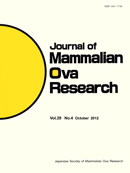30 巻, 1 号
選択された号の論文の8件中1~8を表示しています
- |<
- <
- 1
- >
- >|
Mini Symposium
-
2013 年 30 巻 1 号 p. 1
発行日: 2013年
公開日: 2013/05/23
PDF形式でダウンロード (283K) -
2013 年 30 巻 1 号 p. 2-10
発行日: 2013年
公開日: 2013/05/23
PDF形式でダウンロード (1456K) -
2013 年 30 巻 1 号 p. 11-15
発行日: 2013年
公開日: 2013/05/23
PDF形式でダウンロード (1021K) -
2013 年 30 巻 1 号 p. 16-23
発行日: 2013年
公開日: 2013/05/23
PDF形式でダウンロード (1693K)
Originals
-
2013 年 30 巻 1 号 p. 24-29
発行日: 2013年
公開日: 2013/05/23
PDF形式でダウンロード (522K) -
2013 年 30 巻 1 号 p. 30-35
発行日: 2013年
公開日: 2013/05/23
PDF形式でダウンロード (1155K) -
2013 年 30 巻 1 号 p. 36-40
発行日: 2013年
公開日: 2013/05/23
PDF形式でダウンロード (478K) -
2013 年 30 巻 1 号 p. 41-45
発行日: 2013年
公開日: 2013/05/23
PDF形式でダウンロード (1597K)
- |<
- <
- 1
- >
- >|
